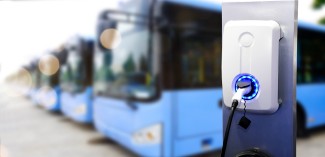Leading utilities are demonstrating how they can help build the chargers needed for electric heavy-duty vehicles projected under proposed emissions standards. To support stronger standards that would deliver greater benefits, more utilities need to increase commitments to deploy chargers.
Vehicle emissions standards recently proposed by the Environmental Protection Agency (EPA) would boost the electrification of trucks and buses, but standards stronger than what EPA proposed are needed to decarbonize transportation at a pace to prevent catastrophic climate change. While leading utilities are showing that they can help build out the infrastructure at the scale necessary to support the proposed standards, they and their customers will need to invest far more ambitiously to support more robust standards.
The proposed “Phase 3” heavy-duty vehicle (HDV) rules include new emissions standards for model years 2027–2032. The EPA projects that the standards would reduce emissions primarily via an increase in zero-emission vehicles (ZEV). This electrification would significantly improve public health and help address today’s climate challenge. Even so, the Truck and Engine Manufacturers Association and American Trucking Associations are pushing to weaken Phase 3 rules, arguing that the lack of sufficient charging infrastructure and uncertainty around the timing of its deployment remain obstacles to the successful rollout of EVs.
Opposition comments hold little merit
Despite complaints, a strong Phase 3 rule is needed to send the necessary market signal to boost the buildout of an extensive HDV charging network. Those warning that the proposed standards levels are unachievable might be surprised to see what utilities—expected to play an important role in helping develop the charging infrastructure—have to say. Edison Electric Institute (EEI), the primary trade organization representing investor-owned utilities, supports the rule at its proposed stringency. EEI is confident that there is sufficient time to deploy charging infrastructure for HDVs to support the proposed rule and is actively planning for it. The trade organization emphasizes that the standards would provide utilities the regulatory certainty needed to proactively plan for the necessary charging infrastructure.
Utilities are increasingly demonstrating how HDV charging infrastructure can be deployed
The electrical load and coordination needed for HDV charging make utility leadership vital. Over the last few years, regulators have successfully approved investor-owned utilities for more than $2 billion in investments for electric vehicle supply equipment (EVSE) for various medium- and heavy-duty vehicles (MHDVs). These investments help utilities fund MHDV charging programs, including make-ready investments (electrical infrastructure to support EV charging), financial incentives (such as charger rebates), and directly installing and owning the EVSE. New York’s major utilities have make-ready programs that can offset up to 100% of utility-side upgrades (not including the chargers themselves), for example, and Southern California Edison, PG&E, SDG&E, Xcel Energy, and Consumers Energy are among the utilities that offer EV charging station installation rebates to fleets.
Proactive planning and early customer engagement with trucking and fleet companies have been vital to making these MHDV programs successful. EEI and Consolidated Edison both stress the importance of early planning in resolving common infrastructure concerns around permitting and construction delays. Utilities are also developing grid capacity evaluation tools and providing dedicated fleet advisory services to avoid infrastructure delays.
California’s San Diego Gas & Electric is investing $107 million across more than 300 commercial and private fleet sites. Southern California Edison similarly envisions establishing over 870 sites to support about 8,500 MHDVs. Utilities are also taking stock of lessons from pilot projects in considering improvements to their medium- and heavy-duty programs. Through the National Electric Highway Coalition, many utilities have committed to support over 4,500 DCFC ports. Some utilities, such as National Grid, are also conducting studies to plan for the development of charging stations to support anticipated MHDVs in their service areas. These studies can serve as important models for utilities that have yet to start planning to do the same.
Utilities must increase investments to support a stronger rule and ramp up HDV charging
Public comments from utilities and their representatives clearly indicate that infrastructure buildout at the proposed level is doable. However, the proposed rule does not realize the full potential for emissions reduction and could reflect much higher EV penetration rates (for example, by applying Advanced Clean Truck ZEV penetration rates for states that adopt that rule before the Phase 3 rule is finalized—among other improvements). While the proposed standards would provide GHG benefits worth $87 billion, increased electrification rates through stronger standards could yield even higher social benefits for avoided GHG emissions (worth $190–231 billion), according to an ICCT analysis. ACEEE thus advocates for a stronger rule to deliver more significant public health and climate benefits.
Given project and regulatory approval timelines, the success of a stronger rule rests on utilities (among other players) accelerating investments sooner. Utility filings to date will only result in 25,000 MHDV charging stations (Level 2 and DCFC). According to a 2021 analysis by Atlas Public Policy, to get on track for all HDVs to be electric by 2040 (a target reflecting higher electrification rates than EPA’s proposed rule), the United States could need between 10,000–93,000 charging ports by 2030 for long-haul trucks alone. Deploying these chargers would require private and public stakeholders to commit between $62–124 billion in investments by 2030—with utility-side upgrade costs being passed on to customers.[1] While utilities are not expected to fund all of it, they will still play a key role in investing in the infrastructure to build (and upgrade) the necessary electrical infrastructure, as well as through other utility programs.
A study commissioned by EDF found that if utilities covered the initial cost of EV infrastructure upgrades, they could generate millions in revenue without increasing ratepayers’ bills. Another study found that, between 2012 and 2017 in California, EVs increased utility revenues more than utility costs. Utilities can reduce their overall investment costs by instituting managed charging programs and increasing charger utilization for HDVs. They also have diverse options to recover the costs of their programs and investments. Thus, if implemented correctly, investments in HDV charging present a lucrative business opportunity for utilities.
Time to step up
Utilities are successfully highlighting their leadership in planning and installing charging infrastructure to support the impending electrification of HDVs. Although utilities are confident in providing the necessary EVSE, they echo the need for regulatory certainty to ramp up charger deployments. The finalization of the Phase 3 rule can provide exactly that. However, to help support a more robust rule resulting in maximum overall benefits worth billions more, more utilities must step up and plan for HDV chargers and associated infrastructure.
[1] The estimate reflects the total investments needed by all stakeholders and assumes the final cost to utilities to be zero (by passing it on to customers). The investment value includes costs other than electrical grid upgrades for items such as hardware, project costs (permitting, etc.), and labor.


